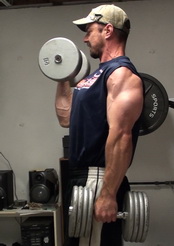There are three primary sticking points that you might run into with the deadlift (not including actually getting the weight off the floor in the first place).
These sticking points are a few inches off the floor, just below the knee and the top lockout. This technique is going to address the first two of them in one shot.
You're going to be doing what is basically a superset for the same exercise, addressing two different range of motion. You'll be doing a bottom-start deadlift, pulling the bar up into the bottom of the safety rails (with a short isometric hold), followed immediately by a rack pull with the bar starting just below the knees.
This method is not anything controversial or revolutionary... it's just effective, targeted hard work.
To do this one, you'll need a power rack and two bars.
Set the safety rails in the power rack to just below knee height. Set up one of the bars below the rails and set the other bar on top of the rails, forward of the path of the first bar (it'll need to be far enough forward that the plates of the two bars don't hit each other).
- On the bottom bar, use a weight that is about 65-75% of your 1 RM. Start with the low-end weight the first time you do it, then progress up from there.
- On the top bar, add another 20-50 pounds over and above the weight you have on the bottom bar.
In the demo, I'm using 315 lbs on the bottom bar and 365 lbs on the top bar. I'm using (and recommend) grip assistance for this method, so grip strength isn't a limiting factor. It also allows you to use a double overhand grip, which is easier on the shoulders and spine (less rotational torque).
Perform the pull out of the bottom, as you normally would.

When the bar contacts the bottom of the rails, continue to pull the bar hard against the rails as though trying to continue the pull to the top. This results in a strong isometric contraction right at that first sticking point.

Continue pulling HARD for 3-5 seconds, then set the bar back down on the ground. Reset your body then do it again. Repeat for 3-5 total reps.
Once you've done that part, step over the bottom bar and immediately get set up in front of the top bar.

The bar should be just slightly below your knees, which is one of the most awkward positions of the exercise (the point right where you are just about to straighten your knees so the bar can clear them).
This is the point where (when using submaximal weight) the acceleration you've already put onto the bar helps you pull through without sticking. When using maximal weight, that acceleration isn't enough to plow through that point and the bar stalls.
Working this point in the range of motion from a dead stop on the rails is going to help you get through that sticking point with muscle strength for when momentum isn't enough.
When working from this point, be sure to keep a tight arch in your lower back and keep your core braced solidly.
Keep in mind, your core will already be fatigued from the bottom-range reps you did right before, so don't put too much extra weight on the top bar or you will find your back starting to round over right away.
If, during the reps, you do find your back position starting to get compromised, end the set there. We want to keep tight form for this.
Repeat for 3-5 reps in this top range, coming all the way up to full lockout, then resetting the bar back down on the rails.
I recommend doing 3-4 total sets of this method with at least 2-3 minutes rest in between sets. Do this once a week, at the most. When done intensely, it's a very demanding technique.
Bottom line, if you want to really improve your deadlift strength, the one thing you absolutely need to do is address your sticking points. This method is a fantastic way to target two of those exact weak positions in the exact movement that you're trying to improve and it WILL increase your deadlift very effectively.
---
Are you 40...50...60 or even 70+ years old and want to build muscle and strength like you did 20 years ago?
If you feel like you're fighting a losing battle, you're ready to discover the REAL secret to REVERSING muscle loss due to aging...
*** You need to train the body systems that SUPPORT your muscle mass, not just the muscle itself. ***
These underlying support systems diminish as you age, which is why you lose muscle as you get older no matter how hard you train... but with strategic training, these systems can be regenerated.
Share This Page...
Want More Strength-Building Techniques and Programs?
You'll find them here...




